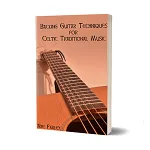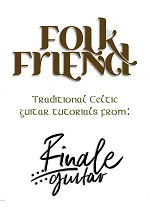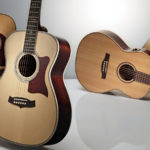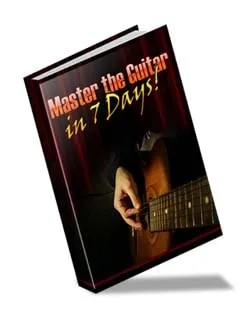Editor’s note: this is another brilliant post by Nye Farley
What key is the tune in?
The first thing you need to know when you’re trying to find the right chords for a tune is its key. Celtic music is written in one of four “modes”. The modes are a set of seven scales which can be made from the intervals within a major scale. If you would like a complete explanation of how they work you can find one in my video on the subject available below, or in my complete folk guitar guidebook, Backing Guitar Techniques for Traditional Celtic Music.
How to spot the mode of a Celtic tune by ear
The simplest way to recognise the mode of a tune is by feeling. The four modes used in Celtic music and their “feelings” are listed below:
| Mode | Mode Number | Difference from major scale | Feeling | Rarity |
| Ionian | 1 | None | Happy, bright, sometimes wistful | Most common major type |
| Dorian | 2 | ♭3, ♭7 | Minor but with a hint of optimism | Most common minor type |
| Mixolydian | 5 | ♭7 | Blues-y, rather cheeky | Less common than ionian |
| Aeolian | 6 | ♭3, ♭6, ♭7 | Very dark and miserable! | Pretty rare |
How to pick guitar chords for Celtic music by ear
Once you have worked out what mode a tune is in, you need to work out what the main chords in that mode are. As I got into teaching folk guitar lessons for beginners, I realised that lots of people struggle to remember which chords go with which modes, so I invented a tool called The Amazing Mode Wheel which remembers it all for you!
You can find out more about how it works or buy your own here. Below I have made up a list of the main major (ionian) keys used in folk music and the main chords for each:
| Key | Chord I | Chord IV | Chord V |
|---|---|---|---|
| G major | G | C | D |
| D major | D | G | A |
| A major | A | D | E |
…But where do the chords go?
It is now fairly straightforward to put the 3 main chords in the right places (I’ll come back to incorporating more varied options later). In the rhythms common in Celtic music, your foot will tap twice per bar. This is about the quickest the average guitarist can change chords too, so let’s assume there are two potential chords per bar.
The average Celtic tune has two sections (the A part and the B part), each of 8 bars / measures, and each repeated twice. Usually, though not always, both sections will be in the same mode. In the example given below the A part is marked in green and the B part in red. Both would be repeated.
There are some set “rules” for basic chord placement. Firstly, chord I pretty much always goes at the start and end of each section of the tune in order to let the listener know what key they are in. Each section will conclude by going from chord V to chord I. Furthermore, usually the fourth bar (or 7th and 8th foot taps) will always be chord V. This gives us an initial framework something like this, where a slash means “play the same chord for another foot tap”:
| I / | ? ? | ? ? | V V |
| ? ? | ? ? | ? ? | V I |
| I / | ? ? | ? ? | V V |
| ? ? | ? ? | ? ? | V I |
Correct placement of chords V and I really is one of the most important things you will learn when you are starting out with Celtic backing guitar- you may find it easiest to count “1, 2, 3, 4, 5, 6, 7, 8” repeatedly in your head until you get good at this!
What about chord IV?
The next thing you need to do is to work out if there are any strong “chord IV sections”. The simplest way I can explain this is that at some points in the tune, the melody will feel like it has “moved away” from the key centre. This is where your IV chord goes. I have demonstrated this principle much more clearly with a classic Irish session reel called Maid Behind The Bar in the video below.
On a more technical level, what you are doing when you pick chords is listening to the notes on dominant (foot tap) beats in the melody. Each chord is made up of three notes from the key scale- chord I contains notes 1, 3 and 5 from the scale. Chord IV contains notes 4, 6 and 8 (which is the same as 1). Chord V contains notes 5, 7 and 9 (which is the same as 2. Each bar contains two “foot tap beats”, and therefore if the bar has a note from a given chord on it, then that’s the chord for that bar.
For example if we had a reel in the key of G major and we heard a bar which went “C D E F# G E F# E” that would sound very much like it needed chord IV. This is because the first dominant beat (bold) is beginning on C, chord IV’s root note.
Please note that I am NOT suggesting that you go through the sheet music picking out which chords should accompany which sections by analysing the notes played on the dominant beats! This is likely to yield very unnatural sounding results and is totally contrary to the entire “by ear” ethos of Celtic accompaniment. I merely feel that it is useful to be aware that the dominant “foot tap” beats of each bar are what you are primarily responding to when picking chords by ear. What you really want to listen out for is the feeling of “moving away” which signifies the need for chord IV.
Adding related chords for variation
Once you have a basic framework for your tune, you can use substitutions to make it more interesting. In the case of major (ionian) keys, the most basic substitution you can do is to swap chords I or IV to their related minors. A related minor chord can be found by going two notes down in the key scale, so for our tune in G major, chord I, G, is related to E minor and chord IV, C, is related to A minor.
Below I have given two example chord grids for a tune in G. The first shows the basic framework using only chords I, IV and V and the second replaces some of the chords with their related minors for variation. Bear in mind that you need to get the feel for any chord IV sections BEFORE you start adding substitutions. As Celtic music is primarily melody driven, it is always better to play simple chords which match the melody than to play complicated ones which do not!
Simple:
| G / | G / | C / | D / |
| G / | G / | C / | D G |
| G / | C / | G / | D / |
| G / | C / | G / | D G |
Related minors:
| G / | Em / | Am / | D / |
| G / | Em / | Am / | D G |
| Em / | C / | Em / | D / |
| Em / | C / | Em / | D G |
You can apply this principle to any tune, in any key.
There is also a further substitution option. Where the related minor chord was two steps below a given major chord, you can also substitute a major chord for the minor chord whose root note is two notes ABOVE its own, which I will refer to as the “upper minor” for the rest of this post. For example in the case of G major we could replace it with Bm and for C we could replace it with Em.
That means that for the above simple chord grid the following would be a perfectly good set of chords:
| G / | Bm / | Em / | D / |
| G / | Bm / | Em / | D G |
| Bm / | C / | Em / | D / |
| Bm / | C / | Em / | D G |
Replacing chord I with chord IV
Finally, for further variation a chord I section can be replaced with chord IV. By extension this also means that you can replace chord I with chord II, because this is related to chord IV!
Below I have compiled a complete list of the chords which you can use in a section of each type, along with an explanation of why it works and an example of what the chord would be in the key of G major.
| Section type | Chord options | Explanations | Examples in G major |
| Chord I | I VI III IV II | Chord I Related minor I’s upper minor IV can replace I IV’s related minor | G Em Bm C Am |
| Chord IV | IV II VI | Chord IV IV’s related minor IV’s upper minor | C Am Em |
| Chord V | V ONLY! | You can’t substitute chord V- if you do the sections don’t sound finished. | D |
This should give you about a billion possible permutations of the simple chord framework- now you just need to try them out and find the ones you like the best! Just make sure to work out your I, IV and V sections FIRST.
What about the dorian, mixolydian and aeolian modes?
 In the interests of brevity I am not going to cover tunes in the other modes in this post, but you can find out how to use the above principles to pick chords for them in my book, Backing Guitar Techniques For Traditional Celtic Music.
In the interests of brevity I am not going to cover tunes in the other modes in this post, but you can find out how to use the above principles to pick chords for them in my book, Backing Guitar Techniques For Traditional Celtic Music.
I also give a comprehensive demonstration of how to apply the principles above to each of the other modes in my videos below:
Chords for Celtic tunes in the dorian mode:
Chords for Celtic tunes in the mixolydian mode:
Chords for Celtic tunes in the aeolian mode:
About the author
 I am Nye Farley, a professional guitar teacher and Youtuber. I provide one-on-one lessons to beginners, song-writers, jazz guitarists and folk players who want to learn how to deconstruct music by ear.
I am Nye Farley, a professional guitar teacher and Youtuber. I provide one-on-one lessons to beginners, song-writers, jazz guitarists and folk players who want to learn how to deconstruct music by ear.
I also own Finale Guitar, a guitar shop in Sheffield, UK.
 I grew up playing along with Irish tunes by ear, thanks to my mum who lived in Ireland for many years and brought her love of the music back with her.
I grew up playing along with Irish tunes by ear, thanks to my mum who lived in Ireland for many years and brought her love of the music back with her.
I later went on to set up the Folk Friend Youtube channel to help other Celtic guitar beginners get into playing by ear.
All the videos shown later in this blog are taken from my free lessons, and you can find hundreds more on the Folk Friend website.




 Sign up to receive a free ebook: Master The Guitar in 7 days! (available for a limited period)
Sign up to receive a free ebook: Master The Guitar in 7 days! (available for a limited period)